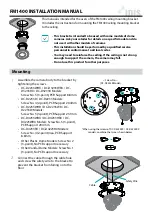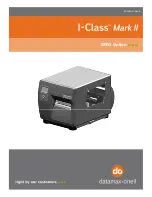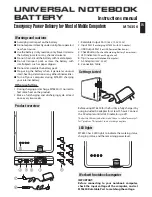
®
Model No.PS-2122
Calibration
2
The Turbidity Sensor makes relative measurements of tur-
bid solutions with a particle size between 0 and 200
microns. Because turbidity is a time-dependent dynamics
phenomenon, factors such as particle density, particle size,
temperature, and pressure may cause reading variation,
especially in repeatability studies. For particle sizes above
200 microns, extract the large particles or allow more time
for measurement.
Suggested Activities
• Compare the turbidity of water sample from various
locations.
• Determine the rate of settling of a sample.
• Measure the formation of a precipitate.
Quick Start
• Plug the Turbidity Sensor into one of the PASPORT
input ports of a PASCO interface (such as the 850 Uni-
versal Interface or SPARK Science Learning System).
• NOTE: If more distance is needed between the sensor
and the interface, connect the sensor to the PASPORT
Extension Cable (PS-2500) and then plug the cable into
the interface.
• Put 6 milliliters (mL) of a fluid sample in a cuvette and
cap it.
NOTE
: Avoid touching the glass with your fin-
gers. Wipe the glass with a non-abrasive cleaning tissue
and/or silicone oil.
• Put the sample cuvette into the Sample Compartment
and close the lid.
• Start the PASCO data acquisition software (such as
PASCO Capstone). Set up a data display in the software.
• Begin recording data.
SETUP:
For more information on setting up the software
and recording data, refer to the User’s Guide and online
help for the data acquisition software.
Calibration
Preparation Procedures: Regular Use
Calibration of the Turbidity Sensor is required the first
time the sensor is used. It is also necessary when you are
measuring solutions with varying temperatures, or when
using different cuvettes. All calibrations are stored inside
the sensor in flash memory.
• To prepare for calibration of the Turbidity Sensor, gen-
tly invert the 100 NTU Standard cuvette (included) five
times. Clean the outside of the cuvette.
• Put 6 mL of deionized water into an empty cuvette and
tighten the cap. Clean the outside of the cuvette.
• Connect the sensor to a PASPORT-compatible interface
land turn the interface on.
• Put the cuvette with the deionized water into the sensor
Sample Compartment and close the lid.
Calibration
• Press and release the green Calibration Button on the
sensor.
• The light-emitting diode (LED) in the button should
turn on.
• When the LED in the button begins to blink, replace the
first cuvette with the 100 NTU Standard cuvette and
close the lid, and press and release the button.
• When calibration is complete, the button LED will turn
off.
• To verify, start the PASCO data acquisition software, set
up a Digits display, and start recording data.
• The Digits display should show approximately 100
NTU ±1 NTU.
• Stop recording data.
Preparation Procedures: Intermittent Use
If the 100 NTU Standard cuvette has been stored for more
than one month, do the following before calibration:
Sensor
PASPORT
Input Port
Interface






















